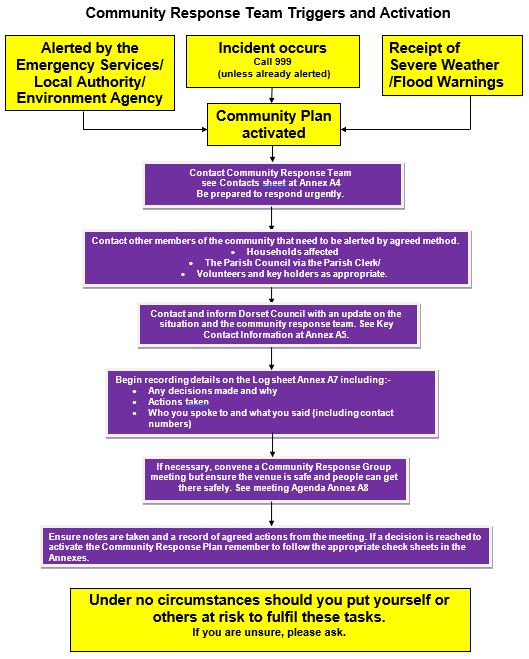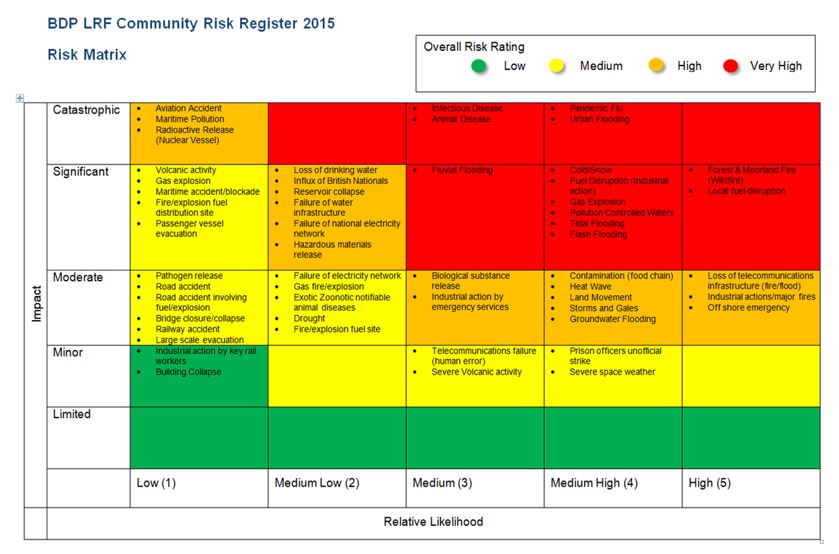-
01725 552211
UNDER CONSTRUCTION
Why is resilience important?
Communities that spend time planning and preparing are best placed to respond to and recover more quickly from local or wider emergencies.
They can use local knowledge and expertiseto identify and prioritise risks and put in place plans to mobilise local skills and resources in response to an emergency
Definition of an emergency
An emergency / major incident is any event or circumstance (happening with or without warning) that causes or threatens death or injury, disruption to the community, or damage to property or to the environment on such a scale that the effect cannot be dealt with by the emergency services, local authorities and other organisations as part of their normal day-to-day activities.
What are the benefits of community resilience?
1. It identifies who in your community might need your help
2. It makes you aware in advance of local risks and mitigation measures which could reduce the likelihood of an emergency occurring
3. Preparing yourself, your family and your community makes it easier to recover from the impacts of an emergency
4. Utilising local knowledge, skills and resources can significantly reduce the impact of an emergency: Local emergency responders will always have to prioritise those in greatest need, especially where life is in danger and during those first few critical hours.
Why develop a Community Emergency Plan?
To increase resilience within the local community (before, during and after emergencies) and to link into the local councils’ (statutory authorities) and emergency services’ emergency response structures.
The Sixpenny Handley and
Pentridge Parish Council Emergency Plan identifies how we would respond in an emergency situation
e.g. while awaiting the assistance of statutory authorities/emergency services,
or in support of them. It is managed by the nominated Emergency Planning Office and Deputy with an annual review as a minimum.
It is not the role of the community to take on the responsibilities of these agencies e.g. to save life; to take any risks to themselves; or to cope for hours without agencies’ help and support.
Plan objectives:
- Identify the risks to the community and relevant response actions
- Identify vulnerable people / groups in the community
- Identify resources available in the community to assist during an emergency
- Provide contact details for the Community Response Group (CRG); key community resources; the Emergency Services; and local councils.
The Emergency Plan contains the following sections:
- Community Response Team Activation Guidance Documents & Response Tools
- Community Response Team Triggers and Activation diagram
- Activation of the Plan
- Role of the Community Response Team Coordinator and Response Team
- Community Response Team contact information
- Key Agencies contact information
- Sample Telephone Tree
- Incident Log summary sheet
- Community Response Team meeting agenda
- Dorset Community Risk Register
- Local Risk Assessment Documents
- Local Skills and Resources
- Community Sandbag Store
- Vulnerable Groups within the community
- Places of safety
- Map of Sixpenny Handley with Flood sign locations
This document has a restricted distribution due to the content including data subject to GDPR. For certain elements additonal information is held by the Parish Council such as voluteers contact information eg Phone, email addresses. All this information is managed in line with the Parish Council Data Protection Policy.
ACTIVATION OF THE PLAN
This plan will be activated when an emergency has occurred, or if warnings are received prior to an anticipated event.
It will also be activated when emergency services need support or are not able to attend immediately e.g. in severe weather.
If this is the case, the Community Response Team will assess the situation, ring Emergency Services if necessary and consult with the District/Borough Council.The Community Response Team will then put all or part of the Plan into effect as appropriate.
Follow Community Response Team Triggers and Activation procedure
Activation of the Plan
Having a Community Emergency Response Plan is not a substitute for calling 999 if there is risk to life. This procedure details the call out order, communicating of information to the community and logging of actions.
- When an emergency happens, the Parish Council will need to know how to activate your plan and contact volunteers as appropriate.
- The Emergency Planning Officer will have made your Community Response Team (CRT) aware of the plan as part of your planning process, so in most circumstances, will activate your plan in response to a call from the local category 1 responders (eg local authority, emergency services etc). The Emergency Officer will work with them to identify how they will contact you and how you should contact them.
- This plan has a series of triggers that can used to decide whether and when to take action.
Using the list of skills, people and resources at for each identified scenario will establish what can be done to safely support the work of the local emergency responders.
Each
Plan has a specific means of activation and appropriate responders eg
Flood, Pandemic or Bad Weather plan. These plans are based on the high
impact categories identified in the following Risk Matrix where the Very
High risks are then further broken down for each plan with more
specific information identified.
USEFUL LINKS
Dorset Council - Here
Communities Prepared - Here

